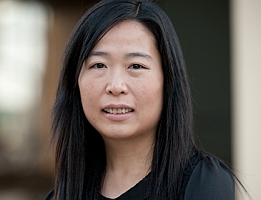Engineers at Stanford University in Palo Alto, California showed that millimeter-sized implanted cardiac devices could be powered by radio waves transmitted from outside the body. The findings from the team led by electrical engineering professor Ada Poon (pictured right) appear online in the journal Applied Physics Letters; paid subscription required.
Poon, with doctoral candidates Sanghoek Kim, John Ho, and Lisa Chen, crafted a prototype implanted device contained in a cube some 0.8 millimeters (0.03 inches) across. Power for the device is derived from electromagnetic radio waves absorbed by a wire coil. The radio waves produce an electrical current in the coil sufficient to operate the device.
To power the coil, the smaller the antenna for capturing the radio waves, the higher the radio frequency needed, and conversely, the lower the radio frequency, the larger the antenna required. But there’s one complication: current mathematical models calculate that high frequency radio waves do not penetrate far enough into human tissue, requiring the use of low-frequency transmitters, which means using a large antenna. A device with a large antenna, of course, would be impractical for implanted devices.
Poon and Stanford colleagues looked further into the problem, which centers around the way human tissue quickly dissipates electric fields. They discovered radio waves can travel as alternating waves of electric and magnetic fields, which enables high-frequency radio signals to travel much deeper into human tissue than had been thought.
The researchers revised their models accordingly and calculated that the maximum power transfer through human tissue occurs at about 1.7 gigahertz (billion cycles per second), much higher than previously thought. “In this high-frequency range, we can increase power transfer by about 10 times over earlier devices,” says Ho, who carried out the mathematical model revisions.
Increasing the power transfer by 10 means they could shrink the antenna size also by a factor of 10, to a scale that makes wireless implantable devices feasible. At the optimal frequency, a coil with a radius of 1 millimeter could harvest more than 50 microwatts of power, well beyond the 8 microwatts needed to power a recently-demonstrated 8-microwatt pacemaker.
The antenna’s size was not the only issue that the team had to address. To get maximum power, the antennas for sending and receiving signals — configured as separate antennas — had to be optimally oriented, otherwise power for the device would dangerously fluctuate. To meet this requirement, the researchers designed the antennas as slots in a bent-cross shape that delivers consistent power efficiency regardless of the orientation of the two components.
The antenna design also focuses the radio waves precisely at the point inside the body where the implanted device rests on the surface of the heart. This configuration increases the electric field to the device, but cancels it elsewhere. As a result, the design helps reduce overall heating of tissue to levels within the IEEE standards for implanted medical devices.
“As the human heart and body are in constant motion, says Poon, “solving this issue was critical to the success of our research.” The university says Poon has filed for a patent on the antenna structure.
Read more:
- Trial Tests Non-Invasive Glucose Monitor in Surgery Patients
- Study: Better Medical Device Security Alerts Needed
- Non-Invasive Hemoglobin Anemia Screening System Unveiled
- Device Company, MIT Test Drug-Delivery Implanted Microchip
- Medical Sensor Powered by Music Vibrations Developed
* * *


 RSS - Posts
RSS - Posts
[…] Feasibility Demonstrated of Tiny Wireless Cardiac Implants […]
[…] Feasibility Demonstrated of Tiny Wireless Cardiac Implants […]
[…] Feasibility Demonstrated of Tiny Wireless Cardiac Implants […]